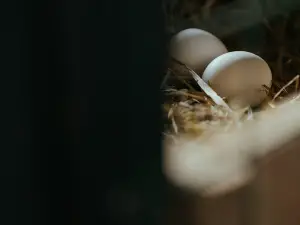
Bird eggs take time and effort to form, they need to be incubated by the male or female parent until they hatch. How long these take to hatch depends on the type of bird in question. After the incubation stage a single tiny bird hatches from the egg, unfortunately, sometimes eggs do not hatch, in this case, the eggs aren’t all that helpful to the parents. So what to do with unattached eggs? This article looks at it.
If you find an unattached egg while out and about there are a couple of ways to deal with it. You can either find the nest and place the egg back in it, you can leave the egg as you found it, you can cook and eat the egg or you can hatch it yourself
Table of Contents
What to do with unhatched eggs?
If you find an unhatched egg in your garden or somewhere in the woods, you should look around for a nearby nest where the egg must have rolled out from and return it there. If you can’t find any nest, then it’s up to you to decide whether to leave the egg just as you found it and let nature take its course, eat the egg (as you can with many types of bird eggs) or you can try to hatch it yourself. If you choose the latter, you’ll need an incubator.
Before incubating an unhatched egg, you should first check to see if the egg is alive or dead. If it’s alive, you can start incubating the egg immediately. If it’s dead, then there’s no point incubating the egg. You can do away with it. This article goes over how to check whether a bird is still alive or not.
What do birds do with unhatched eggs?
When a mother bird lays her eggs, she thinks they will all hatch and so sits on them for the required number of days. If, after the incubation period, one or some of the eggs refuse to hatch, the mother bird will either toss them from the nest or eat them.
Can I hatch eggs with a heat lamp?
If you would like to hatch a bird egg but don’t have an incubator, the good news is that you can make do with a heat lamp. Here’s how to go about it: put the eggs on some hay and in a cardboard box or a bowl and then place a wet towel and the heating lamp just over the eggs. The eggs should start to warm up.
A thermometer is a must-have at this point, as you’ll be needing it to measure the temperature of incubation regularly. If the temperature reads 35 to 40.5°c (84.5 – 104.9°f), you are in the green. If the heat is anything above that then the chicks that hatch from the eggs will be deformed.
Will cold eggs still hatch?
The answer is yes; cold eggs can still hatch. Most bird species do not start incubation until all the eggs in a clutch have arrived. Because of this, there’s a chance that the first egg a mother bird lays will stay without warmth for a couple of days.
Plus, several studies have confirmed that the eggs of birds like chickens, pigeons, doves, and quails can survive for up to seven days without incubation.
How do you tell if an egg is alive or dead?
One way to check if a bird egg is alive or dead is to candle the egg. Candling involves taking the egg into a dark room and using candlelight to see the inside of the egg. If you notice blood vessels or slight movements within the egg, then it is alive. You should also check the shell’s surface for cracks or fractures. If you find any, the egg is most likely dead.
Conclusion
In conclusion, if you find an unhatched bird egg then you have the option of placing it back in the nest, leaving it where you found it to allow nature to take its course, try to hatch the egg yourself or cook and eat the egg as you can with many bird eggs.
The mother of the unhatched egg will roll it out of the nest or eat the unhatched egg. A cold egg can still hatch if you incubate it in time, and you can incubate the eggs with a heat lamp. You can check whether an egg is alive or dead by candling it.
If you enjoyed this article then you may also be interested in other bird related articles. Here are some articles that you may be interested in: can birds see infrared, how to relocate a birds nest with babies, can birds eat grits, can birds eat uncooked grits

